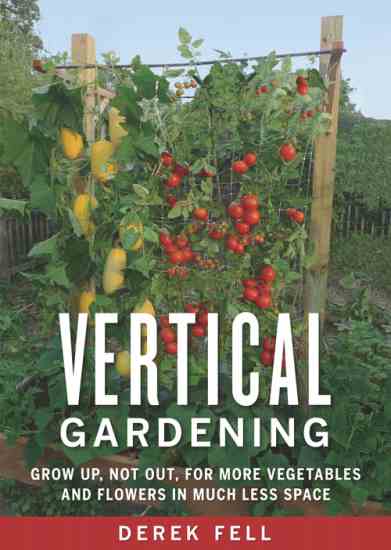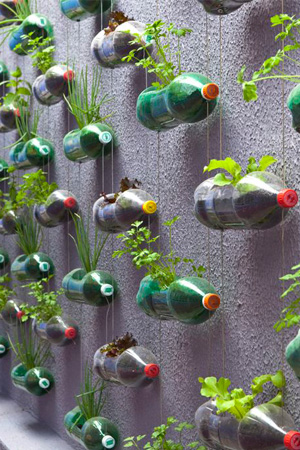As an Amazon Associate, I may earn a commission from qualifying purchases. Please note that you are never charged any extra for that.
Vertical gardening is a method of growing plants upward, using structures. It is ideal for small spaces and urban areas.
In today’s world, space is a luxury. Many people live in apartments or houses with little to no yard space. But, this doesn’t mean they cannot enjoy gardening. Vertical gardening offers a solution. This technique involves growing plants on walls, trellises, or other vertical structures.
It’s a way to maximize space and bring greenery to urban environments. It can be used for flowers, vegetables, or even herbs. Plus, it adds a unique aesthetic appeal to any space. Whether you are a seasoned gardener or a beginner, vertical gardening can be a rewarding and practical way to grow plants. Let’s explore how it works and its benefits.

Credit: www.motherearthliving.com
Table of Contents
Introduction To Vertical Gardening
Vertical gardening is a method of growing plants up instead of out. It uses supports like walls, trellises, and towers. This method is great for small spaces. Vertical gardens can be indoors or outdoors. They add green space and can produce food.
Vertical gardens save space. They allow gardening in small areas. They can improve air quality. They reduce the heat in urban areas. They are easier to maintain and harvest. They can also be beautiful and add to the decor.
Types Of Vertical Gardens
Living walls are also called green walls. They use plants to cover walls. These walls can be inside or outside. The plants grow up the wall. This makes the wall look green and pretty. They help to clean the air. They also make spaces cooler.
Vertical planters are pots stacked on top of each other. They can be made of plastic, wood, or metal. These planters save space. You can grow flowers, herbs, or vegetables in them. They are great for small gardens or balconies. They are easy to move around.
Hydroponic systems grow plants without soil. They use water and nutrients. These systems can be vertical. They are good for growing food indoors. They save space and water. They can grow plants faster. These systems need special care.
Choosing The Right Plants
Some plants grow well in vertical gardens. Consider vines like ivy or jasmine. They climb easily. Ferns and succulents are also good choices. They need little care and look nice.
Herbs like basil, mint, and thyme work well too. They are small and easy to maintain. You can pick them fresh for cooking. These plants make your garden useful and pretty.
Edible plants give you food. Vegetables like lettuce, spinach, and tomatoes are great. They grow fast and are tasty. You can also try strawberries or peas.
Ornamental plants look nice but are not for eating. Flowers like petunias, begonias, and marigolds add color. They make your garden beautiful. Choose plants that fit your space and needs.
Design Ideas
Vertical gardening involves growing plants on a vertical surface, making it ideal for small spaces. This method can beautify walls and maximize limited areas, providing a green touch indoors or outdoors.
Small Space Solutions
Vertical gardening is great for small spaces. You can use walls, fences, or even shelves. Hanging pots or pocket planters are perfect. They save space and look nice. Stacked planters can also work well. These can hold many plants in a small area. Trellises are good for climbing plants. This makes the most of your vertical space. Try to keep things simple and neat. This will make your garden look better.
Indoor Vs Outdoor Designs
Indoor vertical gardens need good light. Use grow lights if natural light is low. Succulents and herbs are good indoor choices. They need less water and care. Outdoor designs can use more types of plants. Vegetables, flowers, and vines are great options. Weatherproof materials are important for outdoor setups. This will make your garden last longer. Choose plants that fit your climate. This helps them grow better.
Installation Tips
Vertical gardening involves growing plants on a vertical surface, maximizing space in small areas. Use sturdy structures and ensure proper sunlight for best results.
Diy Vertical Gardens
Start with a sturdy frame. Choose materials like wood or metal. Make sure the frame is securely fixed to a wall or fence. Use lightweight pots to avoid too much weight. Arrange plants in a way that taller ones are at the top. This ensures they get enough sunlight. Water plants regularly as they dry out faster. Fertilize every few weeks for healthy growth. Regularly check for pests or diseases. Prune plants to keep them neat.
Professional Installation
Hire an experienced professional for the best results. They can design a garden that suits your space. Professionals use high-quality materials. They ensure the structure is safe and durable. Consult them about the best plant choices. They can also install automatic watering systems. This saves time and effort. Maintenance services may be offered. This helps keep your garden in top shape.

Credit: green.org
Maintenance And Care
Proper watering is key for vertical gardens. Use a drip irrigation system. It helps water reach the roots. Avoid overwatering to prevent root rot. Check soil moisture often. Adjust watering based on weather conditions.
Use organic fertilizers for healthy plants. Apply fertilizers every two weeks. Prune plants regularly. This promotes new growth and keeps plants in shape. Remove dead leaves and stems. Healthy plants need less care.
Common Challenges
Insects and pests can hurt your vertical garden. Aphids and spider mites are common. They love to eat your plants. Regularly check the leaves for any signs of pests. Using natural pest control methods is safer for your plants. Neem oil can help keep pests away. Companion planting can also reduce pest issues.
Vertical gardens need strong support. Weak structures can collapse under plant weight. Ensure you use sturdy materials. Regularly check for wear and tear. Fix any loose parts quickly. Water can also damage the structure. Use waterproof materials to avoid this problem. A strong base is essential for support.

Credit: dirt.asla.org
Inspiration And Trends
Vertical gardening is a way to grow plants on walls. It saves space. You can use old pallets or shoe organizers. These make great plant holders. Also, hanging pots from a wall or fence is easy. Trellises help vines grow up instead of out. This creates beautiful green walls. Shelves can hold many small pots. This adds color and life to a room.
Using recycled materials is popular. People use old bottles, cans, and wooden crates. Self-watering systems are in demand. These make it easy to care for plants. Growing herbs and small vegetables is a trend. It provides fresh food at home. Indoor vertical gardens are also on the rise. They improve air quality and make homes look nice.
Frequently Asked Questions
What Is The Meaning Of Vertical Garden?
A vertical garden is a wall covered with plants, often used in urban areas for space-saving and aesthetic purposes.
What Is The Vertical Garden Method?
The vertical garden method involves growing plants on vertically suspended panels, using soil or hydroponics. It saves space and enhances aesthetics.
What Grows Best In A Vertical Garden?
Herbs, leafy greens, strawberries, and small vegetables grow best in vertical gardens. They thrive in limited space and vertical setups.
What Are The Cons Of Vertical Gardens?
Vertical gardens can be expensive to install and maintain. They require regular watering and pruning. Limited plant variety may restrict your choices. Over time, structural support might weaken. Pest and disease management can be challenging.
Conclusion
Vertical gardening offers a smart solution for small spaces. It maximizes growing area while enhancing aesthetics. This method is ideal for urban living, providing fresh produce and vibrant greenery. It also helps improve air quality and reduce stress. Easy to start, vertical gardens are perfect for beginners.
With minimal effort, you can enjoy gardening benefits. Explore this innovative approach and transform your space. Start today and see the difference vertical gardening makes. Happy gardening!
